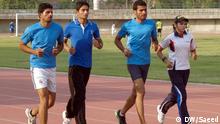Sportswomen need the media to make it big

The Twenty20 cricket world cup always makes it to the front pages. It is followed almost religiously by its fan base. Men and women watch the games with the intense fervour. But few know that the woman’s Twenty20 tournament takes place around the same time every year. The reason is that we see, hear or read very little about most of the women’s sports activities in media.
The coverage of women’s sports events is limited to Olympics and Paralympics. Even in Olympics this year the big news was that Canada’s 307 athletes brought home 22 medals. The fact that the number of Canadian female athletes was more than males was simply ignored.
Except tennis and figure-skating, the coverage given to women’s sports by media is negligible. This partiality shown by media might be because of the glamour factor that is missing from these games. The question that pops up is that why is glamour missing? Women are used to add glamour to events but when it comes to sports, women’s sports have a very little audience. If we look at Olympics, uniform changes for women over the years suggest that people watch with interest only those games where women are scantily dressed. A study has revealed that around 300,000 people watch women’s national basketball association match. On the other hand lingerie bowl has an astounding audience of over a million people.
Recently, the plans to change the uniform of women badminton players and boxers to miniskirts raised eye brows. Nobody cared about the comfort of these women when the plan to change uniform was made. There were players who had never played in a skirt. All that organisers cared about was attractive presentation. Isn’t it about competition anymore? Or do people care more about attractiveness?
When it comes to the prize, men get more than what women receive. Men and women play in the same kind of games and both face equal competition so such a discrimination is unfair.
Prize money indicates the value of the sport and the hard work that athlete puts in. If we look at the recent ICC Twenty20 world cup, the prize money for men was $619,000 and in case of women it was only $37,000. The case is same in other sports. There was a heated debate when like other Tennis grand slams (US open and Australian open) Wimbledon decided to keep the prize money for both men and women equal. There is a stereotypical attitude towards sportswomen considering them inferior to male counterparts. The truth is that women have more flexible bodies and smaller body frame which is of a great advantage if one is a sportsperson. Recently, when skiing superstar Lindsey Vonn decided to race downhill against men in Lake Louise, Canada, her request was rejected on grounds that it was a Men’s championship and there was no place for women in it. In 2003 Annika Sorenstam, golfer, competed against men. When she decided to participate in men’s championship there were criticisms from different quarters, especially from male counterparts. Is it that men underestimate women sports persons? Or are they afraid of the humiliation if women win? Women’s sports has been underestimated by men and under represented by media.
The reason behind the discrimination in prize money and covering the sports is that the sponsorship revenue is not the same. If we take a closer look we find that the women’s sports are trapped in a cycle that hinders the progress. Because of the lack of sponsors the sports don’t get enough coverage. When there is less coverage the audience is not very. Less audience again results into fewer sponsors. On the other hand the sports that men play have a huge audience and a powerful sponsorship. Add to it the small number of women’s professional leagues in comparison to men. The result is undervaluing of women’s sports.
Television and newspapers need to invest in women sports events. ESPN has taken the initiative and have a section on their website exclusively for women’s sports called ESPNW. Women’s sports events need to be on newspaper sports pages and Television sports news bulletins. Once there is proper coverage of the events, there will be more audiences and hence it will pull sponsor support. This shall help in retaining audience attention and as a result more revenue will be generated.
In addition there is a pressing need that more and more women are encouraged to choose sports as career. We lose many talented sports persons every year because of the societal beliefs that sports is not a career choice suited for women. Many decline to choose sports as career because of low salaries.
A study has shown that “women aren’t the ones driving sports viewership (not even women’s tennis); they represent a sizable chunk of the core audience for sports that enjoy overall popularity.” So need of the hour is our support to give a boost to women’s sports.
Author: Ronaq Zahoor
Editor: Manasi Gopalakrishnan






